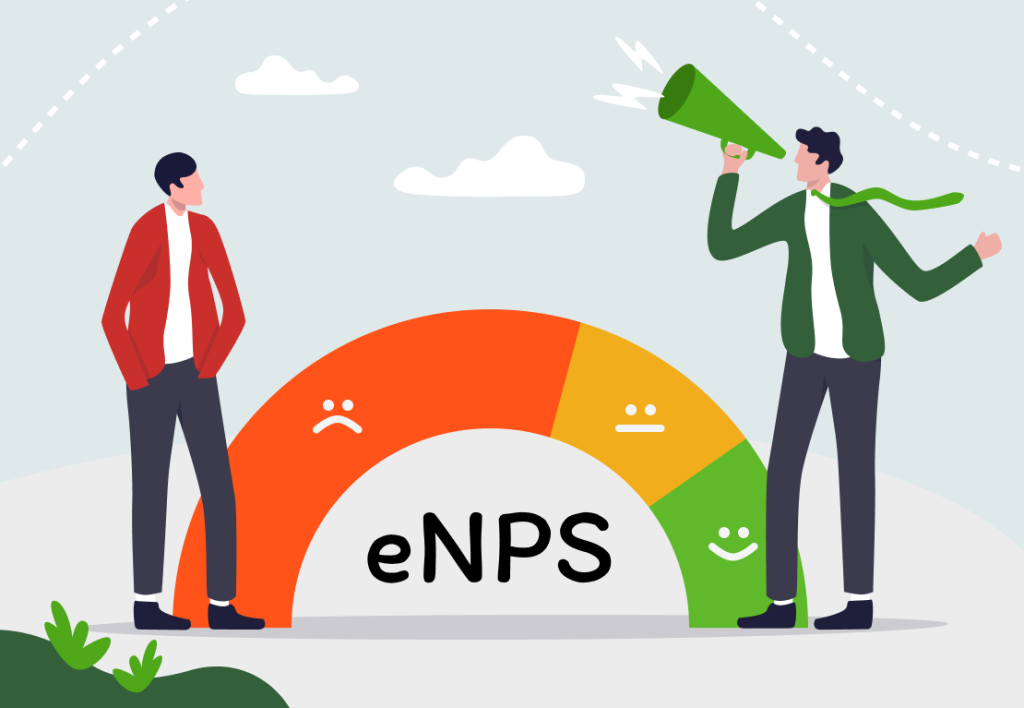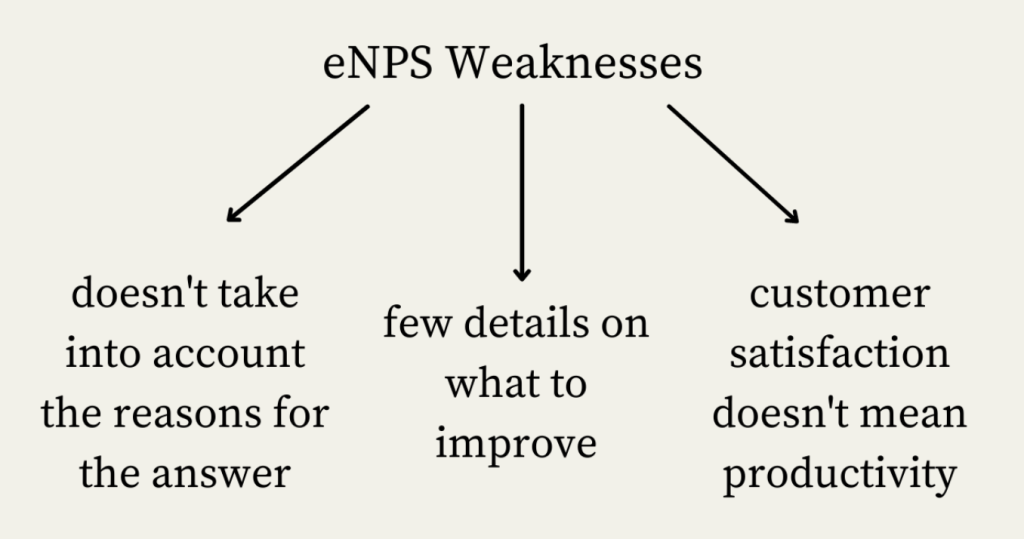What is eNPS, and why your employee engagement strategy needs it?

The employee experience at your business can make or break your reputation, not to mention your company’s success. According to data by Gallup, companies with engaged staff earn 23% more, have 81% lower absenteeism, and have 10% more loyal customers than those with low employee engagement scores.
The good news is that, as an employer, you can foster employee satisfaction and connection to a workplace by implementing an employee engagement strategy. And eNPS (Employee Net Promoter Score) is a metric that can be incorporated into that strategy bringing several benefits to the table.
But what exactly is eNPS, how do you interpret the results, and can you apply them to improve employee engagement strategy at your company? Read on and find out!
Want to get the most out of your time?
Try DeskTime for free!
Try free for 14 days · No credit card required.
By signing up, you agree to our terms and privacy policy.

What is eNPS?
Explaining what eNPS is can only be done by looking into NPS (Net Promoter Score) first.
NPS (Net Promoter Score) is a marketing metric measuring customer loyalty and satisfaction. Instead of lengthy surveys, NPS holds a single question at its core: “On a scale of 0 to 10, how likely are you to recommend our business to a friend or colleague?”
eNPS (Employee Net Promoter Score) is the same but concerns employees and is the most straightforward metric to access employee engagement and loyalty. You ask them to rate how likely a person is to recommend your company as a place to work on a scale from 0 to 10. That’s pretty much it.
According to the answers, respondents who evaluate the company fall into three groups.
- 9 or 10 mark: Promoters. These are the most faithful, content, and emotionally involved team members. They share the organization’s values, advocate for these principles, and attract more candidates. Promoters create a positive image of the company, driving new clients, retaining existing ones, and ensuring profitability as well.
- 7-8 mark: Passives. Passive employees are neutral. They like working in the company but will accept a job offer from another organization. Neutrals won’t talk about the business much (both positively and negatively). So it may be a benefit for you. At least they won’t harm the organization while working diligently and meeting their requirements.
- 0-6 mark: Detractors. This group of people will hardly promote the company to others due to dissatisfaction. Maybe, they are unsatisfied with their role, tasks, rules, or team members. Whatever the reason, they won’t leave positive feedback.
Calculating eNPS
An Employee Net Promoter Score is a number between 100 and -100. To calculate it, you omit neutral personnel but subtract the percentage of Detractors from the portion of Promoters.

To better understand how it’s done, let’s look into two examples of calculation:
- Suppose you have 50 team members. 25 employees are Promoters (50% of your employees), while 10 are Detractors (20% of employees). Then, 50%-20%=30 is your eNPS.
- Again, a team of 50 members, with 25 being Promoters and 10 – Detractors. The eNPS calculation looks like this: (25-10)/50*100=30.
The goal Employee Net Promoter Score varies across industries, but the ultimate aim should be at least 30. If you have a score of 50 or higher, it indicates an excellent level of employee engagement.
Note: Remember to compare the scores with your previous results if you have those. Maybe your current eNPS is 20, but there has been a significant improvement since the last survey, indicating that your employee engagement methods are working. Focus on the dynamics rather than plain numbers.
Benefits of using eNPS for estimating employee engagement

The eNPS metric helps monitor the working environment and take steps to improve employee engagement and satisfaction. Here are some more advantages eNPS can bring:
- It’s one of the easiest assessments. And there is no ambiguity, as the numerical values show the company’s ability to satisfy the staff.
- Another eNPS benefit is speed. You don’t have to compile complex research to understand your workers’ collective mindset. It’s a fast pulse survey to see in which direction the company moves, and you can conduct pulse surveys multiple times a year and keep the workflow uninterrupted.
- eNPS surveys are unlikely to cause survey fatigue – a loss of motivation to participate in assessments and polls. When people are tired of answering questions, the results become inaccurate as employees either don’t support surveys at all or respond for the sake of appearances.
- It doesn’t require complex software to create or share a survey. You can use the usual corporate communication method and drop a survey to respond anonymously at any time and place.
eNPS drawbacks and limitations

Like most survey methods, Employee Net Promoter Score has its drawbacks and limitations. And the primary disadvantage stems from its advantage – its plainness. Other limitations include:
- It’s a derivative of NPS, which measures customer loyalty. Yet, employees have different desires and objectives compared to customers. Clients seek long-term relationships but don’t interact with the organization eight hours a day. Your employees do. That’s why they have higher expectations from the company.
- The eNPS survey is a one-question, one-score metric that doesn’t go into detail. The lack of comprehensive depth doesn’t provide the reasons behind respondents’ answers. Maybe, they answered on the spur of the moment, and their current emotions don’t illustrate the overall experience. You’ll have to add other tools and questions if you need a more detailed review.
- The same numbers may mean different things to people. Employees may rate high even if they don’t like the job. For example, if they can slack off at work without being noticed, they are pleased, but they won’t bring much to the company, let alone their lack of productivity may lead to extra costs for your business.
- The eNPS calculations ignore the opinion of Passives. Passives can also provide crucial insights into employee happiness. There is a chance to convert them into Promoters by removing discouraging elements of their jobs, but eNPS doesn’t display such detailed information.

Want to keep your employees happy?
Encourage your team to keep up a healthy work-life balance.
How to conduct a successful eNPS survey
1. Sustain anonymity
The first tip to gain accurate eNPS is to ensure anonymity. Explain to employees that the goal of the survey is not to detect enemies but to enhance the company’s well-being. As a result, employees will likely provide more detailed and honest feedback.
However, don’t hide the results from your team. Be honest with your scores, even if they are lower than expected. Such honesty will create a stronger bond between you and your staff.
2. Add more questions
Who said you should limit yourself to just one question? Although a traditional eNPS inquiry is whether you recommend the company as a workplace, you can add more questions such as
- What should the company stop or start doing?
- What processes should the business keep?
You’ll definitely receive reasonable pieces of advice.
3. Put the result to good use
Why measure anything if it doesn’t influence the outcome? Stay committed to the feedback and evaluate the existing approaches and patterns within your company’s employee engagement strategy.
If you turn a blind eye to your eNPS, you risk disappointing the Promoters. Besides, Passives can quickly become Detractors and generally lose trust in your surveys. A low eNPS score isn’t the most beautiful sighting, but it gives you space for improvement, and that IS good.
Conclusion
The company grows not only because of increasing customer engagement. Employee engagement is as essential for business success as customer satisfaction because it’s closely related to productivity. That’s why HR managers develop employee engagement strategies.
But how do you plan any steps and understand someone is satisfied? You need to leverage metrics and conduct surveys, e.g.,
- performance assessment;
- collecting feedback from team members;
- reading reviews on the company.
One of the popular polls is eNPS. Consider its pros and cons, keep the results anonymous, and add more follow-up questions to determine reasons for particular scores. If you transform the received results into changes at work, you’ll see how fast a loyal staff can drive your company to prosperity.
This is a guest post by Art Malkovich, a CEO and co-founder at Onilab, a development company focused on eCommerce. He has unique knowledge and comprehensive experience in online store development and project management. Aspiration to keep the company on the top of the market encourages Art to constantly research the spheres of headless commerce and PWA, UX/UI design and m-commerce, Saas, and B2B in general.
Did you find this article useful? Give it a clap!
Psst! You can clap more than once if you really loved it 🙂